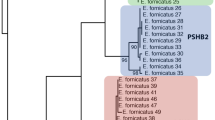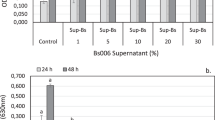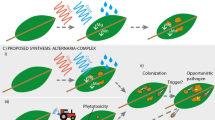Abstract
Alternaria tenuis has been observed to produce antagonistic effects on a number of mycorrhiza-formers for ectotrophic tree species. The two active strains of A. tenuis tested were isolated from two forest nursery soils of the arable type in which this fungus is generally abundant. Reactions of the mycorrhizal mycelia to the antagonistic principle of A. tenuis were recorded for mixed cultures on a synthetic medium (glucose, 20 gm. ; magnesium sulphate, 0.1 gm. ; ammonium chloride, 0.5 gm. ; potassium dihydrogen phosphate, 1 gm. ; malt extract, 20 gm. ; agar, 15 gm. ; distilled water, 1,000 c.c.) in the following order of degree : Boletus granulatus, B. variegatus—markedly inhibited ; B. bovinus, Rhizopogon luteolus—inhibited ; B. scaber—mildly inhibited. The accompanying photograph demonstrates the condition of B. scaber eight weeks from inoculation.
This is a preview of subscription content, access via your institution
Access options
Subscribe to this journal
Receive 51 print issues and online access
$199.00 per year
only $3.90 per issue
Buy this article
- Purchase on Springer Link
- Instant access to full article PDF
Prices may be subject to local taxes which are calculated during checkout
Similar content being viewed by others
References
Brian, P. W., Nature, 155, 637 (1945).
Rayner, M. C., Nature, 156, 174 (1945).
Author information
Authors and Affiliations
Rights and permissions
About this article
Cite this article
LEVISOHN, I. Antagonistic Effects of Alternaria tenuis on Certain Root-fungi of Forest Trees. Nature 179, 1143–1144 (1957). https://doi.org/10.1038/1791143c0
Issue Date:
DOI: https://doi.org/10.1038/1791143c0
This article is cited by
-
Effects of Gibberella fujikuroi on Fungal Root-infections of Pinus
Nature (1960)
-
Biological antagonisms due to phytotoxic root exudates
The Botanical Review (1960)
Comments
By submitting a comment you agree to abide by our Terms and Community Guidelines. If you find something abusive or that does not comply with our terms or guidelines please flag it as inappropriate.



